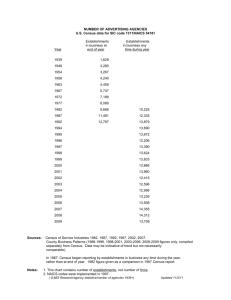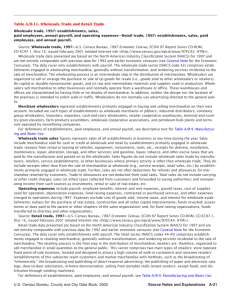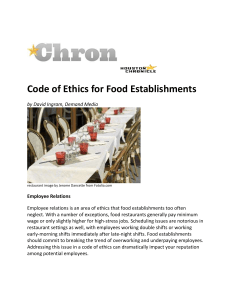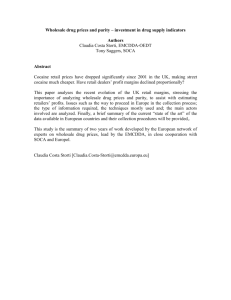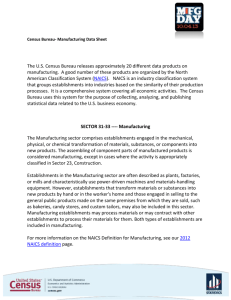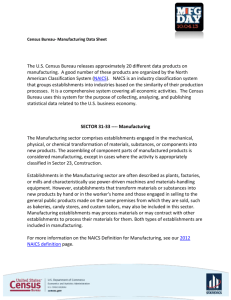Notes on the Commerce Statistical Survey
advertisement
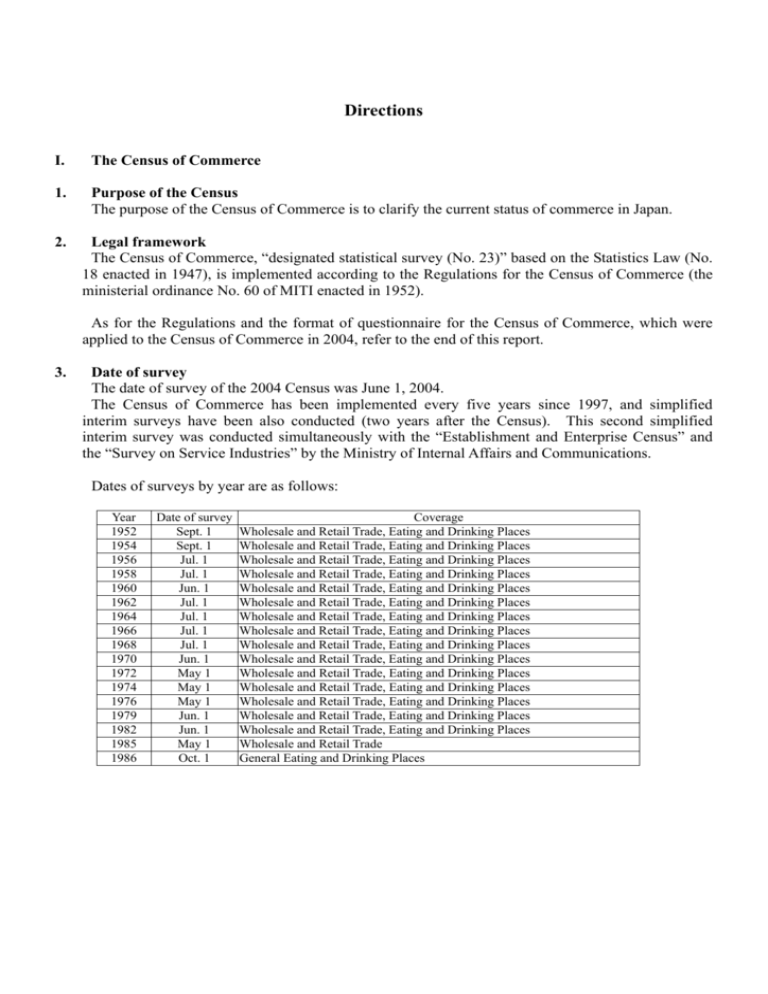
Directions I. The Census of Commerce 1. Purpose of the Census The purpose of the Census of Commerce is to clarify the current status of commerce in Japan. 2. Legal framework The Census of Commerce, “designated statistical survey (No. 23)” based on the Statistics Law (No. 18 enacted in 1947), is implemented according to the Regulations for the Census of Commerce (the ministerial ordinance No. 60 of MITI enacted in 1952). As for the Regulations and the format of questionnaire for the Census of Commerce, which were applied to the Census of Commerce in 2004, refer to the end of this report. 3. Date of survey The date of survey of the 2004 Census was June 1, 2004. The Census of Commerce has been implemented every five years since 1997, and simplified interim surveys have been also conducted (two years after the Census). This second simplified interim survey was conducted simultaneously with the “Establishment and Enterprise Census” and the “Survey on Service Industries” by the Ministry of Internal Affairs and Communications. Dates of surveys by year are as follows: Year 1952 1954 1956 1958 1960 1962 1964 1966 1968 1970 1972 1974 1976 1979 1982 1985 1986 Date of survey Sept. 1 Sept. 1 Jul. 1 Jul. 1 Jun. 1 Jul. 1 Jul. 1 Jul. 1 Jul. 1 Jun. 1 May 1 May 1 May 1 Jun. 1 Jun. 1 May 1 Oct. 1 Coverage Wholesale and Retail Trade, Eating and Drinking Places Wholesale and Retail Trade, Eating and Drinking Places Wholesale and Retail Trade, Eating and Drinking Places Wholesale and Retail Trade, Eating and Drinking Places Wholesale and Retail Trade, Eating and Drinking Places Wholesale and Retail Trade, Eating and Drinking Places Wholesale and Retail Trade, Eating and Drinking Places Wholesale and Retail Trade, Eating and Drinking Places Wholesale and Retail Trade, Eating and Drinking Places Wholesale and Retail Trade, Eating and Drinking Places Wholesale and Retail Trade, Eating and Drinking Places Wholesale and Retail Trade, Eating and Drinking Places Wholesale and Retail Trade, Eating and Drinking Places Wholesale and Retail Trade, Eating and Drinking Places Wholesale and Retail Trade, Eating and Drinking Places Wholesale and Retail Trade General Eating and Drinking Places Year 1988 1989 1991 1992 1994 1997 1999 2002 2004 Date of survey Jun. 1 Oct. 1 Jul. 1 Oct. 1 Jul. 1 Jun. 1 Jul. 1 Jun. 1 Jun. 1 Coverage Wholesale and Retail Trade General Eating and Drinking Places Wholesale and Retail Trade General Eating and Drinking Places Wholesale and Retail Trade Wholesale and Retail Trade Wholesale and Retail Trade (simplified interim survey) Wholesale and Retail Trade Wholesale and Retail Trade (simplified interim survey) 4. Scope of the Census The scope of the Census of Commerce covers establishments belonging to “DIVISION J-WHOLESALE AND RETAIL TRADE” indicated in the Standard Industrial Classification for Japan (No. 139, announcement of the Ministry of Internal Affairs and Communications in 2002). The simplified interim survey is intended for private (excluding national and local government) establishments. It also covers establishments managed separately, such as stores in companies, governmental offices, schools, and plants, as well as non-store retailers, such as door-to-door sales and mail order and catalogue sales. Among private establishments, ones inside facilities into which entry is charged, such as those inside a ticket gate in a station, a theater, a sports arena, or a toll road are not covered by the Census. However, establishments managed separately inside charged parks, amusement parks, and theme parks are included in the Census. Establishments no longer in business, in liquidation, or in seasonal business are also included if there are full-time workers. 5. Routes of Survey The routes of survey of the Census are as follows. The survey is conducted by the following two methods. (1) Survey by enumerators in which questionnaires are filled in by subject establishments (self-recorded method) Supervisors of enumerators ( METI Minister (2) ' ( Prefectural Mayors of cities, wards, ' governors ' towns and villages Enumerators for Census of Commerce Respondents ' (Establishments) A blanket survey method in which a company submits questionnaire, produced in a bloc for each establishment under the control of a head office to METI or local governments directly METI Minister or prefectural governors ' Subject companies 6. Survey items All of the following survey items (1–10) are for incorporated establishments. Item 8 is omitted for individuals. However, for foreign companies, non-company corporations, and unincorporated organizations, item 8 is omitted. Item 10 is a survey item for retailers only. 1. 2. 3. 4. 5. 6. 7. 7. Survey items Name and telephone number of establishment 8. About company (paid-up capital, number of Location of establishment regular employees in entire company, kind of Legal structure major business in entire company) Head office and/or branch 9. Annual product sales and other (annual product Year of opening of establishment sales, other income) Number of employees of establishment 10. Sales floor space and other (sales floor space, Kind of business of establishment existence of self-service system, business hours, etc.) Publication The results of the Census of Commerce in 2004 were publicized as the “Report of the Census of Commerce” as shown below. Type Main contents Mainly providing statistical charts by industrial classification, by stratum Vol.1 Results by Industry of number of employees, class of annual product sales, class of sales floor (National Tables) space, and others Vol. 2 Results by Industry Mainly providing statistical charts by industrial classification by (Prefectural Table) prefectures, Tokyo special wards and ordinance-designated cities Vol. 3 The Report by Providing statistic charts by industrial classification by municipalities Industry (Municipality Table) (Secondary elaboration) Type Results by Kind of Business Results by Site Characteristics Main contents For retail establishments, mainly providing statistical charts by industrial classification by kind of business For retail establishments, providing statistical charts by site characteristics by industrial classification, kind of business, and prefectures, and on large-scale retail stores by characteristics II. About the Reports (Vol.1-3) of the Census of Commerce in 2004 1. Classification for the Census of Commerce The classification for the Census of Commerce complies with the Standard Industrial Classification for Japan in principle (see “industrial classification table” and “commodity classification table” at the end of this report). 2. How industrial classification of establishments is decided Establishments are classified by industry according to the following procedure. The 2004 Census was a simplified interim survey, adopting not the 5-digit industrial classification used in the full-scale census, but a simplified 3-digit industrial classification. Some industry groups are subdivided by adding a letter after the third digit. (1) Common method 1) When an establishment deals with a single commodity, the industry is decided based on 3 digits of commodity classification number. 2) When an establishment deals with multiple numbers of commodities, the industry is decided by the following method. a. Wholesaler or retailer Whether the establishment is a wholesaler or retailer is decided by comparing sales amounts of wholesaling divisions and retailing divisions in annual product sales, and finally taking the one with larger amounts. b. Industry major group (2-digit industrial classification) After deciding whether it is a wholesaler or a retailer, the industry major group is decided by classifying and tallying up the first 2 digits of the commodity classification numbers of the top three items, and taking the largest proportion of sales amounts. c. Industry group (3-digit industrial classification) After deciding the industry major group, among commodities belonging to the industry major group, the industry group is decided by classifying and tallying up all 3 digits of commodity classification numbers, and taking the largest proportion of sales amounts. (2) Specific method “Wholesale trade, general merchandise”, “Miscellaneous wholesale trade, general merchandise”, “Agents and brokers” in wholesale trade, “Department stores and general merchandise supermarkets”, “Miscellaneous retail trade, general merchandise”, “Retail trade, general merchandise”, “Convenience stores”, and “Tobacco and smoking article specialty stores” in retail trade, are classified as follows. 1) Wholesale trade (a) 49A Wholesale trade, general merchandise (with 100 or more employees) These are establishments selling commodities belonging to Table 1 (producer goods, capital goods, and consumer goods), with respective sales proportion of those three goods at or over 10% of total sales in wholesaling, and having 100 or more employees. The establishment classified as “4911 Wholesale trade, general merchandise (with 100 or more employees)” in the 2002 Census is regarded as “49A Wholesale trade, general merchandise (with 100 or more employees)”. However, in case of the number of employees dropping below 100, it is regarded as “49B Miscellaneous wholesale trade, general merchandise”. (b) 49B Miscellaneous wholesale trade, general merchandise These are establishments selling commodities belonging to Table 1 (producer goods, capital goods, and consumer goods), with respective sales proportion of each major group less than 50% of total sales in wholesaling, and having fewer than 100 employees. Establishments classified as “4912 Miscellaneous wholesale trade, general merchandise” in the 2002 Census are regarded as “49B Miscellaneous wholesale trade, general merchandise”. However, in cases where the number of employees is 100 or more, the common method to classify wholesalers is adopted. In the above-mentioned (a) and (b), even if the establishment handles commodities ranging from producer goods and capital goods to consumer goods, the common method to classify wholesalers is adopted in cases where the item of producer goods is only “524 RECYCLED MATERIAL”, or the item of consumer goods is only “549 OTHER PRODUCTS, N.E.C.”. Table 1 By goods Group 501 Producer goods Capital goods 522 523 524 521 531 532 533 539 502 511 Consumer goods 512 541 542 549 Industrial classification TEXTILE PRODUCTS (EXCEPT APPAREL, APPAREL ACCESSORIES AND NOTIONS) CHEMICALS AND RELATED PRODUCTS MINERALS AND METALS RECYCLED MATERIAL BUILDING MATERIALS GENERAL MACHINERY AND EQUIPMENT MOTOR VEHICLES ELECTRICAL MACHINERY, EQUIPMENT AND SUPPLIES MISCELLANEOUS MACHINERY AND EQUIPMENT APPAREL, APPAREL ACCESSORIES AND NOTIONS AGRICULTURAL, ANIMAL AND POULTRY FARM AND AQUATIC PRODUCTS 51A Rice, barley and other cereals 51B Vegetables and fruits 51C Meat and poultry 51D Fresh fish, shellfish and seaweed 51E Miscellaneous agricultural, animal and poultry farm and aquatic products FOOD AND BEVERAGES FURNITURE, FIXTURES AND HOUSE FURNISHINGS DRUGS AND TOILETRIES OTHER PRODUCTS, N.E.C. (c) “54A Agents and brokers” After the 2002 Census, establishments earning substantial commission are classified under this heading, comparing annual product sales and other income. Establishments classified as “5497 Agents and brokers” in the 2002 Census are regarded as “54A Agents and brokers”. 2) Retail trade (a) “551 DEPARTMENT SUPERMARKETS” STORES AND GENERAL MERCHANDISE (b) (c) (d) (e) These are establishments retailing commodities ranging from clothing (major group 56), food products (major group 57), to housing (major group 58-60) in Table 2, with respective sales proportion of those three goods at or over 10% and less than 70% of total retail sales, and with 50 or more employees. Establishments classified as “5511 Department stores and general merchandise supermarkets” in the 2002 Census are regarded as “551 DEPARTMENT STORES AND GENERAL MERCHANDISE SUPERMARKETS”. However, cases where the number of employees drops below 50, they are regarded as “559 MISCELLANEOUS RETAIL TRADE, GENERAL MERCHANDISE (WITH LESS THAN 50 EMPLOYEES)”. “559 MISCELLANEOUS RETAIL TRADE, GENERAL MERCHANDISE (WITH LESS THAN 50 EMPLOYEES)” These are establishments retailing commodities ranging from clothing (major group 56), food products (major group 57), to housing (major group 58-60) in Table 2, with respective sales proportion of those three goods less than 50% of total retail sales, and with less than 50 employees. Establishments classified as “5599 Miscellaneous retail trade, general merchandise (with less than 50 employees)” in the 2002 Census are regarded as “559 MISCELLANEOUS RETAIL TRADE, GENERAL MERCHANDISE (WITH LESS THAN 50 EMPLOYEES)”. However, in cases where the number of employees is 50 or more, the common method to classify retailers is adopted. “571 GROCERY STORES” Among establishments classified as the major group “57 RETAIL TRADE (FOOD AND BEVERAGE)”, these are establishments retailing commodities belonging to three or more groups from 572 to 579, where any of those sales are less than 50% of retail sales of beverages and food products. Establishments classified as “5711 Grocery stores” in the 2002 Census are regarded as “571 GROCERY STORES”. “57D Convenience stores, only for sell food and beverage at staple” Among establishments classified as “57 RETAIL TRADE (FOOD AND BEVERAGE)”, these are establishments adopting self-service systems with sales floor space of 30 m2 or more, but less than 250 m2, and 14 business hours or over. “60P Tobacco and smoking article specialty stores” These are establishments where sales of “60P Tobacco and smoking articles” are 90% or over in total retail sales. Table 2 By clothing, food products, housing Major group Clothing 56 Food products 57 58 Housing 59 60 Industrial classification DRY GOODS, APPAREL AND APPAREL ACCESSORIES FOOD AND BEVERAGES MOTOR VEHICLES AND BICYCLES FURNITURE, HOUSEHOLD UTENSIL AND HOUSEHOLD APPLIANCE MISCELLANEOUS RETAIL TRADE 3. Explanation of major terms (1) (2) (3) Establishment (Commercial Establishments) This is “an establishment purchasing and selling tangible commodities” occupying a certain place (a block), and generally called a wholesaler or retailer, in principle. Wholesale trade This is an establishment mainly conducting the following business. 1) An establishment to sell commodities to retailers or other wholesalers 2) An establishment to sell large amounts and volumes of commodities to industrial users (construction, manufacturing, transport, eating and drinking places, accommodation, hospitals, schools, governmental offices, and others) for industrial use 3) An establishment to sell commodities for industrial use (machinery and furniture for offices, equipment for hospitals, beauty salons, restaurants, hotels, etc., industrial machinery (excluding agricultural machines and implements), and building materials (lumber, cement, sheet glass, tiles, etc.)) 4) A wholesale establishment managed by a manufacturing company in a separate place for the company’s own products (excluding an establishment chiefly for administration) For example, in a case where a branch or a sales office of a household electric appliances manufacturer sells its own products to wholesalers, it is regarded as a wholesale establishment. 5) An establishment to sell commodities by wholesale, and repair same kinds of commodities Even if income from repair work is larger, the establishment selling the same kinds of commodities is regarded not as a repair shop but as a wholesaler. 6) An establishment to carry out or mediate purchase and sale of commodities for other establishments, mainly earning commission (agents and brokers) “Agents and brokers” generally includes establishments called agents, brokers, and collectors of agricultural products. Retail trade Establishments engaged in the following are classified as retail trade: 1) Establishments engaged in commodity sales to individuals (including unincorporated agricultural, forestry or fishery establishments) or to household consumers 2) Establishments engaged in sales of small quantities or sums of commodities to industrial users 3) Establishments engaged in sales of commodities and repair services of the same kind Even in cases where the income from repair fees exceeds that of sales of the same kind, these establishments are classified as “retail trade” instead of “repair shops”. However, establishments engaged exclusively in repair are classified as “repair shops” (DIVISION Q-SERVICES, N.E.C.). In this case, replacement of parts for repair is not considered retail of products. 4) “Manufacturer-retailers” (establishments selling manufactured commodities to individuals or household consumers at outlets within the establishment premises, for example, confectioneries, bakeries, lunch providers, tofu stores, and pharmacies etc.) 5) Gasoline service stations 6) Establishments mainly engaged in sales of commodities without having sales space (including establishments with a base office that engages in sales activities necessary for door-to-door sales or mail order and catalogue sales), and mainly selling to individuals or household consumers 7) Establishments managed separately Shops that exist in premises of governmental offices, corporations, factories, organizations, amusement parks etc., and are managed by other establishments, will be classified as “retail trade” as individual establishments. (4) Single-unit establishment Establishments without any head office, branch, or sales office managed by the same entity in other places (1 enterprise with 1 establishment) (5) Head office Establishments that control all branches and sales offices managed by the same entity in other places In cases where each division of a head office is scattered over different places, the establishment to which a representative such as a president belongs is regarded as “head office”, and other offices as “branches”. Previously establishments with branches and sales offices as sales establishments were regarded as “head offices”, and those without them as “single-unit establishments”. (6) Branch Establishments subject to control from a head office in another place, including establishments with the name of “branch office”, as well as sales offices, stands, substations, and shops run by joint enterprise cooperatives mainly engaged in selling commodities. Intermediate local head offices controlling subordinate establishments while controlled by the head office at a higher level are also regarded as “branches”. (7) Year of opening Previously the time when the establishment started operation of business was regarded as the “year of opening”. However, in the 2004 Census, it is the time when that establishment opened, regardless of business content. (8) Employees and persons engaged Number of persons who are engaged in business of the establishment as of June 1, 2004. The number of employees is the total of “sole proprietors”, “unpaid family workers”, “paid officers”, and “regular employees”. The number of persons engaged is calculated by (1) adding the number of “temporary employees” and “workers dispatched from other companies” to employees, and then (2) deducting the number of “workers dispatched to other companies among employees and temporary employees” from (1). 1) “Sole proprietors” are those proprietors who are actually engaged in the individual business. 2) “Unpaid family workers” are those family members who are regularly involved in the business without being paid. 3) “Paid officers” are executives of enterprises and organizations being paid regardless of whether they are full-time or part-time. 4) “Regular employees” are those usually called “full-timers” or “part-timers” who come under any of the following definitions: a. Persons employed without a contract for an indefinite employment period b. Persons employed for a period of one month or longer c. Persons other than a. or b. above who were employed for 18 days or longer per month for both April and May 2004 5) “Temporary employees” are those workers other than regular employees employed for a period of less than one month or on a daily basis. 6) “Workers dispatched from other companies” are those workers dispatched from temping agencies or from establishments with different management. 7) “Workers dispatched to other companies among employees and temporary employees” are those workers dispatched to and engaged in business of other establishments managed separately, such as subcontractors for other companies, among employees and temporary employees. (9) Annual product sales Annual product sales mean the annual sales amount of tangible goods (consumption tax included) in that establishment for the period of April 1, 2003 to March 31, 2004. (10) Other income Other income is the total of income gained from business operations other than the sales of tangible goods, such as repair, commission, manufactured goods shipments, food and beverages, services and so on for the period of April 1, 2003 to March 31, 2004 (including consumption tax). (11) Self-service system (retailers only) The “self-service system” is a method of sales which fulfils the following three conditions: 1) Goods are unwrapped, or pre-packed with pricing. 2) The consumer individually carries the desired goods in shopping baskets or carts. 3) The consumer pays the total amount for the goods at the cashier. Establishments that are considered to adopt the “self-service system” for the purposes of the census are those establishments that fulfill the above conditions in at least 50% of the total sales floor space of the establishment. (12) Sales floor space (retailers only) The aggregate sales floor space actually used for retail sales of the establishment as of Jun 1, 2004. Dining rooms, tea lounges, exterior exhibition space (garden plants, rocks), distribution centers, stairways, walkways, elevators, escalators, lobbies, lavatories, offices, warehouses, spaces leased to tenants and so on are excluded. (13) Business hours (retailers only) Business hours as of June 1, 2004, rounded down to the nearest whole hour In cases where the date of the survey is different from usual cases due to leaves or special sales etc., business hours of a usual working day close to the date of the survey are used. 4. Explanation and note on items in each statistics table Common elements (1) “Not reported” “Not reported” at the top and side of a statistics table means that the census is not implemented on that item. (a) As for “sales floor space”, the census is not implemented for establishments belonging to retailers of milk, automobiles, fixtures, tatami mats, newspapers, and gasoline service stations, as well as establishments without sales floor space, such as door-to-door sales, mail order and catalogue sales. (b) As for “business hours”, the census is not implemented for establishments belonging to retailers of milk and newspapers. (2) 5. As for figures by industrial classification for “annual product sales” and “other income”, the sum of the figures may not necessarily equal the total, due to the process of rounding the figures down to 100 thousand yen and indicating the monetary amount in millions. Others (1) (2) (3) (4) (5) 6. The “−” mark in the table indicates that there is no relevant figure, “0” and “0.0” that the figures are less than the minimum unit of description. “x” indicates that the figures gained for the item are for 1 or 2 establishments only and that the reporter determines that confidentiality may be compromised by the disclosure of the figures. However, even when the figures are gained for more than 3 establishments, when it is apparent that confidentiality will be compromised by disclosure of the figures, they may be restricted. For the “composition rate” given in the text or tables, due to the process of rounding the figures, the sum of the figures may not necessarily equal the total. The 1991 Census was not implemented for Shimabara city and Fukae village in Minami Takaki county of Nagasaki Prefecture due to the eruption of Mt. Unzen-Fugen. Therefore, the figures (number of establishments, number of employees, total sales during the year) of the 1991 Census do not include the figures for this area. The 2002 Census was not implemented for Miyake village on an island included in the Tokyo metropolitan area due to volcanic activities. Therefore, the figures (number of establishments, number of employees, annual product sales) of the 2002 Census do not include the figures for this area. When reprinting the figures given in this Census, the source must be cited as “2004 Census of Commerce, Research and Statistics Department, Economic and Industrial Policy Bureau, Ministry of Economy, Trade and Industry”. Inquiries For any inquiries in respect of the Census, please contact: Industrial Statistics Office, Research and Statistics Department, Economic and Industrial Policy Bureau, Ministry of Economy, Trade, and Industry 1-3-1 Kasumigaseki Chiyoda-ku Tokyo, 100-8902 Tel. 03-3501-9945 03-3501-0386 (direct line) The major contents of this text may also be found on the homepage of the Ministry of Economy, Trade and Industry. URL access to statistics: http://www.meti.go.jp/statistics/ Part 2.for Incorporated establishments
